Centauri Dreams
Imagining and Planning Interstellar Exploration
Corridor of Ice Identified on Titan
What an interesting thing Titan’s atmosphere turns out to be. A fine haze produced by sunlight breaking apart methane molecules settles continuously to the surface, leaving organic liquid and solid sediments. Titan also has large lakes, but these contain about a third of the necessary methane, available through evaporation, to replenish that atmosphere, which should be depleted over geological time scales. What produces Titan’s supply of methane?
It was to answer that question that Caitlin Griffith (University of Arizona Lunar and Planetary Laboratory) and colleagues embarked on a study of cryovolcano activity on Titan. Cryovolcanoes erupt not with molten rock but volatiles like water or methane, and thus could provide an answer if they are venting methane found in subsurface reservoirs. A feature on Titan’s surface called Sotra shows cryovolcanic features that imply past icy flows.
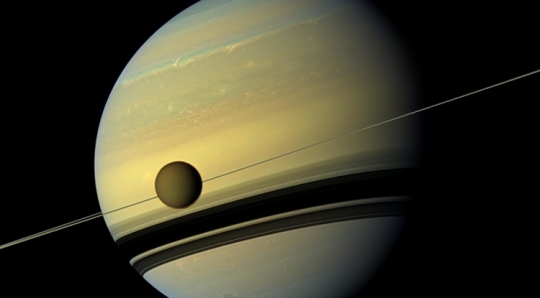
Image: A giant of a moon appears before a giant of a planet. Titan, Saturn’s largest moon, measures 5,150 km across and is larger than the planet Mercury. Credit: NASA/JPL-Caltech/Space Science Institute.
Thus the need for a study of Titan’s surface focusing on potential cryovolcano candidates. But this is tricky work, with weaker spectral features difficult to tease out because of the moon’s dense atmosphere. The work draws on tens of thousands of spectral images produced by Cassini’s Visible and Infrared Mapping Spectrometer. The team developed a principal components analysis (PCA) which allowed a more fine-grained breakdown of surface ice and sediments at the four wavelength bands that most clearly view Titan’s surface from orbit.
Out of this came the detection of an icy linear feature, a ‘corridor’ in Griffith’s words, and one that raises questions:
“This icy corridor is puzzling, because it doesn’t correlate with any surface features nor measurements of the subsurface. Given that our study and past work indicate that Titan is currently not volcanically active, the trace of the corridor is likely a vestige of the past. We detect this feature on steep slopes, but not on all slopes. This suggests that the icy corridor is currently eroding, potentially unveiling [the] presence of ice and organic strata.”
Based on the settling of sediments from the atmosphere, scientists expect the surface of Titan to be an ice bedrock coated with organic materials. What the team has found is that water ice is unevenly exposed in Titan’s tropical latitudes. The exposed icy materials do indeed appear as a long, linear corridor that stretches 6,300 kilometers, with the aforementioned Sotra region especially rich in water ice, and positioned roughly in the middle of the icy corridor.

Image: Three orientations of Titan’s globe: the icy corridor is mapped in blue. Credit: NASA/JPL-Caltech/Space Science Institute.
All of this relates to the methane question, because the distribution of organic sediments on the surface is, the researchers believe, related to the history of Titan’s interior. We seem to be seeing evidence of a past, geologically active period. As Griffith notes, the icy feature does not correlate with topography as measured by Cassini’s radar measurements, nor does it seem to correlate with gravitational field anomalies likewise noted by Cassini, which offer a limited measure of subsurface composition. Just when did it appear, and how? From the paper:
The linearity of the icy corridor over a global scale presents the question of whether tectonic processes shaped this feature, thereby manifesting the processes that mould Titan’s surface and subsurface on a global scale. However, we find no evidence that Titan is geologically active, consistent with Titan’s long-wave topography and gravity field, which indicate a thick ice shell that is conductive rather than convective.
The answer may lie in the past, with methane surging up from below:
Measurements of the 13C/12C ratio in Titan’s atmosphere indicate that methane was injected into the atmosphere not more than 0.5-1 billion years ago. This age is consistent with the volume of dunes that would have accumulated since then, and suggest, consistent with evolution models of Titan’s interior, that a major cryovolcanic event occurred several million years ago. Potentially the topography that established the steep slopes of the icy corridor is a remnant of the time when Titan was geologically active. One example is the Sotra region, which displays cryovolcanic features, the steep terrain of which exhibits the strongest water-ice features.
Thus a past cryovolcanic event could explain Titan’s methane, with the ice corridor a telling reminder of these processes. Icy features in other parts of Titan are found only in local regions exposed by erosion or cratering, which suggests that if cryovolcanism remains an active process on Titan, it is not widespread. The team plans to use the same techniques to examine Titan’s poles, where the moon’s methane seas are prominent, to explore these ideas further.
The paper is Griffith et al., “A corridor of exposed ice-rich bedrock across Titan’s tropical region,” Nature Astronomy 29 April 2019. Abstract.

Refined Parameters for an Expanding Universe
When it comes to matching what we know of the early universe, as seen in the Cosmic Microwave Background (CMB), with what we see today, astronomers have their work cut out for them. Edwin Hubble could demonstrate that the universe was expanding by studying the redshift of galaxies as they receded, but the rate of that expansion has been controversial. Now we have new work based on data from the Hubble Space Telescope as well as the Araucaria Project (about which more in a moment) that is helping us refine the Hubble constant (H0) to tighten the parameters on how the universe’s expansion is accelerating.
The result: The universe is expanding some 9 percent faster than we would expect based on observations by the European Space Agency’s Planck satellite, which mined data from the CMB from 380,000 years after the Big Bang. Exactly what drives this accelerated expansion — an enhanced interaction between matter and something we have yet to detect, ‘dark’ matter, or the as yet unknown form of energy likewise called ‘dark’ — no one knows.
Nonetheless, our cosmos is doing something that we need to explain. Nobel laureate Adam Riess (Johns Hopkins University and Space Telescope Science Institute) is lead researcher on this work. Riess’ Nobel came in 2011, shared with Saul Perlmutter and Brian Schmidt for demonstrating that the expansion of the universe was accelerating. We now firm up that discovery yet further. Riess says the chances of this observation being in error have dwindled from 1 in 3,000 to 1 in 100,000, adding “This disparity could not plausibly occur by chance.”
“This is not just two experiments disagreeing,” Riess added. “We are measuring something fundamentally different. One is a measurement of how fast the universe is expanding today, as we see it. The other is a prediction based on the physics of the early universe and on measurements of how fast it ought to be expanding. If these values don’t agree, there becomes a very strong likelihood that we’re missing something in the cosmological model that connects the two eras.”
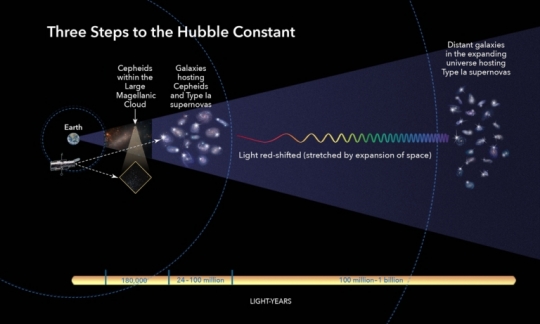
Image: This illustration shows the three basic steps astronomers use to calculate how fast the universe expands over time, a value called the Hubble constant. All the steps involve building a strong “cosmic distance ladder,” by starting with measuring accurate distances to nearby galaxies and then moving to galaxies farther and farther away. This “ladder” is a series of measurements of different kinds of astronomical objects with an intrinsic brightness that researchers can use to calculate distances. Credit: NASA, ESA, and A. Feild (STScI).
Riess is working with a team called SHOES, for Supernovae, H0, for the Equation of State, which analyzed the light of 70 Cepheid variable stars in the Large Magellanic Cloud. Cepheid variables are ‘standard candles’ that brighten and dim at predictable rates, making it possible to measure the distance between galaxies. On the immediate level of data acquisition, the team was able to sharply reduce the time normally required for studying a Cepheid with Hubble (one star for every 90 minute orbit). Using a technique called Drift And Shift (DASH), Hubble can take quick ‘point and shoot’ images, considerably speeding the process.
With the Hubble data in hand, Riess combined them with observations from the Araucaria Project, which is an international collaboration studying the calibration of extragalactic distance, with considerable attention to Cepheid variables, RR Lyrae stars and other potential distance markers. The group has used eclipsing binaries to tighten our distance estimates to the Large Magellanic Cloud. The combined data helped refine the true brightness of the Cepheids.
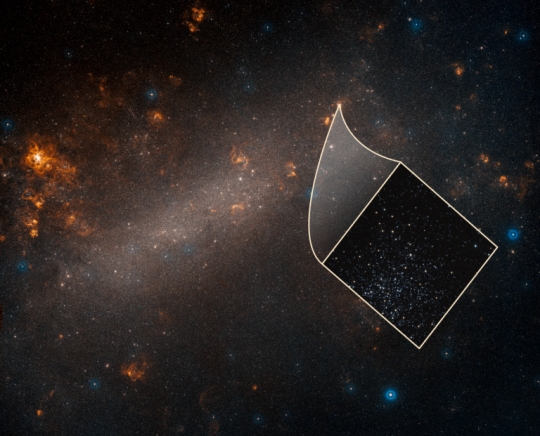
Image: This is a ground-based telescope’s view of the Large Magellanic Cloud, a satellite galaxy of our Milky Way. The inset image, taken by the Hubble Space Telescope, reveals one of many star clusters scattered throughout the dwarf galaxy. Credit: NASA, ESA, Adam Riess, and Palomar Digitized Sky Survey.
We get a new estimate of 74.03 kilometres per second per megaparsec for Hubble’s constant, which means that for every 3.3 million light years further away a galaxy is from us, it appears to be moving 74 kilometers per second faster. This is a result of the expansion of the universe, and as mentioned above, is a figure 9 percent higher than the Planck observations of the early universe. The latter pegged the Hubble constant at 67.4 kilometres per second per megaparsec.
Consider the values we’ve determined for the Hubble constant in recent decades. A factor of two separated estimates of the constant in the days before the Hubble Space Telescope was available. By the late 1990s, the Hubble Space Telescope Key Project on the Extragalactic Distance Scale refined the value to within 10 percent. By 2016, with the discovery that the universe was expanding faster than previously calculated, the uncertainty dropped to 2.4 percent. What Riess and team have done is to reduce that figure down to 1.9 percent.
“The Hubble tension between the early and late Universe may be the most exciting development in cosmology in decades,” says Riess. “This mismatch has been growing and has now reached a point that is really impossible to dismiss as a fluke.”
And where do we go from here? From the paper (note the reference to gravitational waves, as well as to the supernovae used to extend distance measurements deeper into the cosmos):
A new feature in the dark sector of the Universe appears increasingly necessary to explain the present difference in views of expansion from the beginning to the present… Continued pursuit in precision in the determination of H0 is also needed to transition from the discovery of a difference to a diagnosis of its source. Additional observations of giants and pulsating stars in more hosts of SNe Ia [supernovae] are underway and should further refine H0. Less predictable but highly sought are contributions from gravitational wave sources as standard sirens (Schutz 1986; Abbott et al. 2017; Chen et al. 2018). Improvements in parallaxes from future Gaia data releases are also expected to continue to increase the precision of the distance ladder in the near term.
The paper is Riess et al., “Large Magellanic Cloud Cepheid Standards Provide a 1% Foundation for the Determination of the Hubble Constant and Stronger Evidence for Physics Beyond LambdaCDM,” accepted at the Astrophysical Journal (preprint).

Probing Parenago: A Dialogue on Stellar Discontinuity
The publication of a paper called “New Features of Parenago’s Discontinuity from Gaia DR1 Data” by V. V. Vityazev and colleagues brought us a new look at an unusual observation. Parenago’s Discontinuity refers to the fact that red, cooler stars move faster in the direction of galactic rotation than blue, hotter stars, based on Hipparcos data. But is the phenomenon just a chance, local observation? Fortunately, a much larger dataset from the Gaia mission has now become available, and it is this that the Vityazev paper addresses in terms of Parenago’s finding. The following dialogue between Greg Matloff and Alex Tolley goes to work on the Vityazev document. Dr. Matloff has pointed to the Discontinuity as a possible marker of consciousness among low temperature stars, where molecular bonds can form.
Could motion be a matter of agency in such stars? Greg explored the idea in his book StarLight, StarBright. Now Alex digs into the Vityazev paper and questions whether Greg is right that his controversial theory can be falsified given our data. Various mechanisms for stellar motion are explored, ranging from coronal mass ejections to possibilities that are downright Stapledonian. How exactly would a civilization go about moving stars? I am preserving the dialogue format of the original correspondence as a case in point of serious differences being discussed in a way that both disputants have found valuable.
By Greg Matloff and Alex Tolley
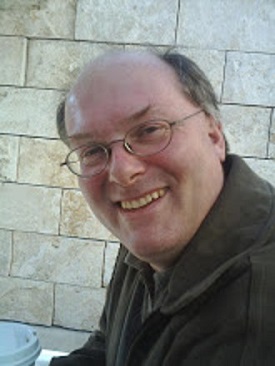
Alex: Greg, in your 2012 Centauri Dreams post Star Consciousness: An Alternative to Dark Matter, you made the claim that there was an alternative explanation to dark matter for the velocity of stars around the galactic center. Your hypothesis was some sort of psychokinesis effect generated by consciousness, even if a primitive one. You used the Parenago Discontinuity (PD), which showed that velocity was related to star type, to suggest that fast stars were cool and that these cool stars could have chemistry, allowing some sort of consciousness. The 2015 Centauri Dreams post Greg Matloff: Conscious Stars Revisited further elaborated on this hypothesis.
The first problem I have with the data you used is that there was no plateau of velocity, but rather a peak, unlike the classic Parenago Discontinuity, which showed a plateau. This would imply that star types reach a peak velocity, then decline. Why would there be such an effect if consciousness was the driver of some psychokinetic effect? A possible explanation could be the amount of material that could be expelled to propel the stars.
The issue was left on whether the Parenago Discontinuity was purely a local, rather than galactic effect. We awaited the Gaia data.
The Vityazev paper using Gaia data confirmed that the Parenago Discontinuity was indeed non-local and that the peak effect around B-V of 0.7 seen with the earlier data you presented was indeed correct. As you had hung the hypothesis on the Parenago Discontinuity, this confirmation with the larger data did not falsify the interpretation that stars might be conscious.
The Hipparcos satellite measured the distances to hundreds of thousands of stars. It also measured the magnitude of each star through two filters:
A blue filter, yielding a B (for “blue”) magnitude
A greenish filter, yielding a V (for “visual”) magnitude (the human eye has highest sensitivity in the green)
Now, astronomers call the difference between the B and V magnitude of a star its (B-V) color, or sometimes just “color” for short. Remember how magnitudes work: large numbers mean “faint”, and small numbers mean “bright”. What is the “(B-V) color” of a hot star?
Figure 5 in the Vityazev paper seems to offer the basis for the more likely explanation of the PD results.
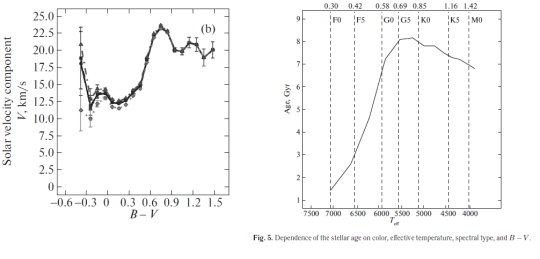
The figure 1b graph (left) shows the PD with the Gaia data. The figure 5 chart (right) shows that the PD effect is correlated with stellar age, rather than stellar temperature. The cooler stars in the sample are actually younger than G stars at the age peak. The shape of the B-V vs age graph matches the B-V vs azimuthal velocity (V) graph. This seems to me to suggest that velocity is therefore related to age, and more likely due to some physical factor related to time.
This seems to me to be the most parsimonious relationship and should be chosen by Occam’s razor. The stellar conscious hypothesis has to account for this age relationship and explain why the coolest stars that should have good consciousness and can, for unknown reasons and unknown mechanisms, chase around the galaxy faster than large, hotter stars, nevertheless go more slowly than G-type stars.
Why stars increase velocity with age still needs elucidation and modeling. However, the Vityazev paper has broken down the many components of stellar kinematics. This should provide a nice set of constraints for validating computational models.

Greg: The fact that Parengo’s Discontinuity is apparently non-local supports my hypothesis and does not support density waves. I have gone through the Messier, Herschel, and NGC Catalogues and reported my results in several publications. No known diffuse nebula in our galaxy or the Clouds of Magellan is large enough to drag along stars over a ~1,000 light-year radius sphere. The fact that stars seem to move faster along the direction of galactic motion as they age is very interesting, but it does not bear upon my original hypothesis that the discontinuity occurs at the point where molecules come in to stellar spectra. It is in my data as well as the data in the paper, so I presume that it is correct. I had originally ignored it because it does not bear on the original hypothesis. I presented in my original letter to Paul and others the causes I could think of to explain this phenomenon. But please, don’t hesitate to present others.
I am pretty happy right now because I predicted a non-local Parenago Discontinuity and this has apparently been verified. No one else, to my knowledge, had made this prediction. The local alternative explanations are now extinct. But science works by constructing alternative explanations for a phenomenon and testing them. Please do so. Try your hand at galaxy-wide possible alternative explanations. I can think of a few that won’t work. I am very interested in what you and others come up with and look forward to a dialogue of competing ideas.

Alex: The chart below is a rough conversion of the B-V values to age (from Figure 5) and the velocity from figure 1b. This seems to show that the Parenago Discontinuity might be a phenomenon based on using a variable (stellar type) that isn’t really related to the star’s velocity. Using age provides an approximately linear trendline with an R-squared of 0.93.
I accept that this velocity might be hard to explain (I am certainly not able to comment on this) but the relationship of age to velocity does seem to point to a simpler explanation for V based on natural forces, rather than requiring agency.
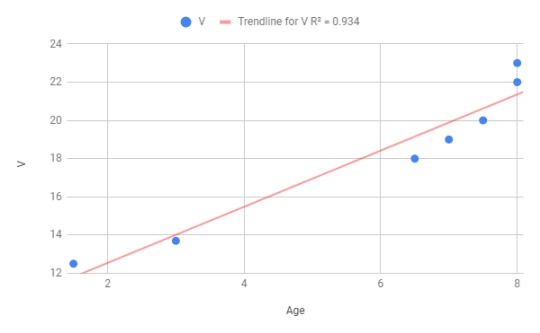
This older reference looked at A and B stars and examined the velocity differences based on age. There were clear differences based on age, rather than stellar type. While this doesn’t invalidate your hypothesis, they do have a physical explanation on why age impacts star velocity. To my mind, such approaches should be examined further before resorting to more exotic explanations. With the Gaia data, astronomers involved in kinematics studies now have a trove of high-quality data to test their models. I would be looking amongst that cadre for cutting-edge modeling.

Greg: Nice analysis! What I tried to do is put all the cards, as I see them, on the table. I am not and never have been an advocate for psychokinesis. But science seems willing to accept the Multiverse, which can perhaps not be verified. It accepts dark matter and invokes many properties for this stuff even though it remains hidden. I have discussed PK and the Geller/Randi controversy with people on both sides and find nothing wrong with their arguments. So I believe, with David Kaiser of MIT and others, that the case should be reopened. If a weak PK force can be demonstrated to the satisfaction of the scientific community, it should be considered an option.
I also believe that the stellar age variation has little to do with Parenago’s Discontinuity. Why does the discontinuity appear at the same place where molecules come in to stellar spectra?? And why indeed is it a discontinuity instead of a smooth curve? Invoking strange (and unknown) stellar variability to explain it is certainly an exotic explanation!
One of the problems with what we are discussing comes from the fact that I was checking the metaphysics of Olaf Stapledon, a sci-fi author and philosopher, and attempting to see if there is something scientific behind his discussion in Star Maker. If I were starting afresh, I would title my work (as I have done in subsequent papers) “A Test of Self-Organization on the Galactic Scale?”, since astrophysicist Erich Jantsch uses “self-organization” as a possible explanation of consciousness. Alternatively, I might go with the terminology of philosophers such as David Chalmer and title my papers “Is Panpsychism a Science?”
I think that the work that you have done on (B-V) vs. star age from the Gaia Release 1 sample is invaluable and should be included in our published dialogue. I hope very much that our debate leads to further work with future Gaia data releases.

Alex: Let me give you a perspective from a biologist’s point of view. The Parenago Discontinuity might have an analogy to living vs non-living, where living things can be observed to grow, move (or have tropisms), reproduce, etc. Let us assume that cooler stars have some sort of motility which is driven by a “need”, perhaps acting something like a bacterium. Bacteria can be observed to move faster in their medium if they have flagella. A biologist would ask “what is the evolutionary advantage of movement given the cost” and might hypothesize that this leads to faster food discovery, or a phototropism, or evasion of larger predators. In the case of cool stars, I would be asking similar questions. Why is V (azimuthal velocity) the key variable, rather than a different direction (U, W)?
Given that V is affected by star type, what is the advantage of moving faster in one direction? One might hypothesize that this facilitates sweeping up of neutral gas clouds more effectively, but this would be even better if the stars moved in the opposite direction. Are the stars perhaps self-organizing into “flocks” and what we are seeing is the movement of the flock which is currently going in the V direction? With bacteria, we know that it is flagella that allow movement through the medium. With stars, one mechanism is with a Shkadov drive to asymmetrically create thrust. Another might be directed coronal mass ejections (CMEs). In the former case, it is not the star that is sentient, but more likely a separate intelligence, a more Stapledonian idea.
Therefore another hypothesis is that stars are being driven by a galactic wide intelligence[s] to reach a certain unified velocity for some reason. The age relation to velocity then makes sense if the Shkadov drives need billions of years to reach the needed velocity. For what purpose?
One idea might be to facilitate more frequent stellar encounters allowing biological civilizations to disperse more easily among the stars. On the other hand, if the galaxy is an organism or superorganism, perhaps the Parenago Discontinuity is some process to organize older stars for some equivalent of a cellular process.
An obvious question suggests itself. If cooler stars are somehow able to direct their velocity, shouldn’t very cool stars, i.e. red dwarfs and brown dwarfs, also have that behavior? We don’t have enough examples of BDs to determine this, but it would provide another datum. One might extend this to gas giant planets too. While the ones we know about are bound to their stars, is it possible that planetary migration is a related phenomenon? Are “hot Jupiters” exhibiting similar behaviors?
Clearly one can speculate endlessly. If the relevant variable is time rather than stellar type, then this constrains mechanisms to those that require both time and a reason for the more uniform direction. With such a constraint, looking for a natural process that requires billions of years would seem to be the most fruitful direction. That velocity W (fig 1c) is fairly constant, but U (fig 1a) declines with stellar type suggests to me that physical forces are somehow directing the movement into the W direction, whether those forces are natural or artificial. The direction is apparently translating from U, towards the galactic center, to V, a transverse direction, rather like the Coriolis forces operating on weather patterns that “shape” the velocity profile.
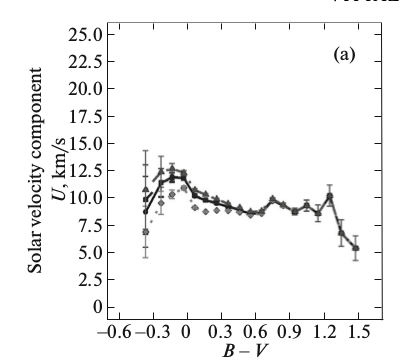
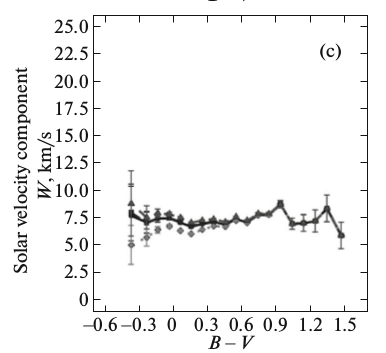
If time is the relevant variable, then looking for young, cool stars should be the best way to test the hypothesis. If they are fast, then stellar type is the key variable, but if slow, then time. The Vityazev paper also has limited data for red giant stars. If anything, the G, K and M red giant stars have more uniform V than main sequence stars, i.e. they seem to conform more closely to the classic PD plateau. Whatever the mechanism, size is clearly not a variable as they have velocities comparable to the oldest G stars. Creating an age chart for these stars might also be instructive.
Unfortunately, even if age is the relevant variable, it doesn’t falsify your hypothesis. The mechanism of acquiring a high V might simply require time, whether a natural, external force or an inner, self-directed one. Just as with determining which animals are conscious (e.g. using the mirror test), we need a better test to be able to falsify your hypothesis. We may be in the position of trying to determine sentience of a herd of buffalo from a still photograph when what we need is video or many photographs over time.
PS: A back-of-the-envelope calculation shows that a star could attain the necessary velocity by directing its radiant energy (e.g. Shkadov drive), but not by directed coronal mass ejections. (calculation for our sun).

Greg: Wonderful! My feeling has always been that stars need not have a high level of consciousness–they could be like slime-mold amoeba or developing cells in embryos.
I suspect that Vityazev et al could not use the red giant Gaia data for the same reasons the Burnham’s validation of Parenago for giants looks so fluffy. Since most of these stars are very distant, astrometric parallax is impossible with Hipparchus and the early Gaia data.
Spectroscopic distance estimates using the HR diagram are accurate to 10% or less. Also, what is the local reference standard when the subject stars occupy a sphere thousands of parsecs in radius? Hopefully, future Gaia data releases will offer the possibility of greater accuracy.
Also, I have been thinking about your suggestion regarding unknown forms of stellar variability. My suggestions in the earlier emails–EM radiation anisotropy and unidirectional jets in mature stars–are two of these. Perhaps there are others!

Greg: The Shkadov thruster could of course be a form of anisotropic EM emission from the star. But could such a thruster develop in a purely materialistic setting not requiring a Kardashev Type 2 civilization in that star’s system or volition on the part of the star?
It is so strange that we are encountering so many fascinating intellectual insights at the same time that national governments are failing. Last Sunday we attended a talk by Tyler Volk, a biologist at NYU. He has constructed a geometric/architectural model of self-organization from the quark to universal levels. Tyler suspects that we are moving towards the planetary phase of our civilization and this is the use of apparent political dysfunction. I hope he is correct.

Alex: Greg, you write: “The Shkadov thruster could of course be a form of anisotropic EM emission from the star. But could such a thruster develop in a purely materialistic setting not requiring a Kardashev Type 2 civilization in that star’s system or volition on the part of the star?”
I would be skeptical about EM emission asymmetry as I would have thought this would be detectable. A Shkadov drive with mirrors would definitely have some observable effects. Even just some “magical” control over EM emissions should be detectable.
While CMEs are not energetic enough, a small star with large CMEs that are accelerated to c might just work. But again, I would think such a beam would be detectable. I agree with you that such EM or particle control would need K2 civilizations to manage. With so many stars that would be exhibiting such high V’s, just by chance we would detect some anomalies, and solve the SETI question too.
It also occurs to me that since our galaxy has experienced a collision with another galaxy or satellite in the remote past, with a corkscrew effect on velocities, is there any chance this might in some way be responsible for the Parenago Discontinuity?
Let me refer to a post here on Centauri Dreams titled Gaia Data Hint at Galactic Encounter. I could imagine that an old collision with another galaxy or similar massive object accelerated stars which retained their higher velocities while younger stars maintain the velocities of birth in a more stable galaxy post-collision. To get the age-related relationship, it suggests that the collision must have had its impact on velocity over billions of years. Perhaps the values of U, W and V can be used to determine the likely form of the collision?

Greg: Regarding the Shkadov thruster discussion, have you read the Benford/Niven novels Bowl of Heaven and Shipstar? These discuss an advanced version of this concept. I have given some thought to a galactic collision producing Parenago’s Discontinuity. According to the computer simulations done at Cornell (and likely other places), when the Milky Way collides with Andromeda to form Milkimedia (what a horrible name!), there will be widespread disruption of diffuse nebulae. This might result in a Spiral Arms Density Wave effect drawing lower-mass stars along faster than their more massive colleagues.
But the same simulations indicate that the combined galaxies lose their spiral shapes after merger. The ultimate result is a giant elliptical with few nebulae and a very low rate of star formation. Since this has clearly not occurred for the Milky Way galaxy (which is a nice barred spiral), it is reasonable to conclude that such a galactic merger did not happen. From what I understand, galactic cannibalism (where a big galaxy gobbles a smaller one) has less disruptive effects–the big guy retains its shape (which might be an argument for self-organization on the galactic scale.

Alex: From an engineering point of view, I think controlling the solar wind might be a lot easier than deflecting the EM with a solid mirror. I would envisage surrounding the star in a charged, superconducting “mesh” to trap the protons. These would be funneled to electromagnetic accelerators to emit the protons in a unified direction at near c velocity. That might be enough to accelerate the star over the needed timescales. The advantage is lower mass requirements and no impact on the star’s light emissions or spectrum. However, I would expect that the proton beam emitted would be detectable. Think of this drive as a giant ion engine coupled with a ramscoop that captures the protons from the star, rather than from the interstellar medium as in a Bussard ramjet.
The Centauri Dreams link I provided was for a proposed “impact” with a dwarf galaxy (the Sagittarius dwarf galaxy). Much smaller than M-31, and if there was an impact, it certainly hasn’t disrupted the shape of our galaxy. What is interesting is the analysis technique that teased out the spiral shape of the velocity-position phase space that was too subtle to visualize with pre-Gaia data. This sort of analysis might offer a better way to understand the stellar type/age vs velocity relationship. Figure 2 in the paper referenced in the article shows the structure in the azimuthal (V) direction vs the radius (I cannot interpret if this has any possible bearing at all on the Parenago Discontinuity, but the same analysis teasing out stellar type might well do. It might be worth contacting the principal author regarding this approach. Paper attached)
[The paper Alex is referring to is Antoja et al., “A Dynamically Young and Perturbed Milky Way Disk,” Nature 561 (2018), 360-362 (abstract / preprint).]

Greg: Nice paper! Thanks for it. But can this effect bear on an apparent near-linear relationship between galactic revolution velocity and star age? I think that such dwarf galaxy absorptions by the Milky Way are rare events. Regarding the Shakdov thruster, you are (I think) correct. But could we detect a proton flow necessary to increase V by ~1 km/s over a 10 billion year time interval? Certainly fuel for thought.

Alex: Given the large numbers of stars in the sample, I was thinking that the stellar type vs velocity relationships could be plotted for locations on the galactic disc. If they are all the same, that would tell a different story than if they differed in shape. There is a hint of this in the Vityazev paper where they plot thin vs thick disk stars that show differences. In other words, given the large sample size, it should be possible to show more granularity based on location than with the averaging that Vityazev computes.
Incidentally, I came to the same conclusion with regards to CMEs. However, even for our sun, the CMEs are within a single order of magnitude if they are accelerated to c. As the solar wind produces more protons overall than CME, the same approach might work. However, this approach has to work for all stars, so the mass loss of protons/star mass has to increase for cooler stars for this mechanism to describe the PD observation.
I am not aware of the idea of moving stars by trapping and accelerating the solar wind and flares, so possibly it is novel. I also wonder if it is possible to direct solar flares by manipulating the surface magnetic fields of the star so that they break and cause a flare in desired positions. As the star rotates, the magnetic field is broken when the alignment is correct, releasing the flare. The flare material still needs to be accelerated to have the desired thrust, so electric fields could do that, or something more like a linear particle accelerator. Definitely K2 or even K3 level engineering…or just maybe some phenomenon than a “living” star could manage.

Greg: The differences between disc star velocities and others in the Antoja et al paper is fascinating. I don’t think it bears on Parenago unless somehow large diffuse nebula were created in the galactic merger. These could have perhaps caused differential velocities between massive and less massive stars. But such nebula would have to be perhaps an order of magnitude larger in radius than those in today’s galaxy to encompass a stellar sphere with a radius in excess of 1,000 light years. A further problem is that these structures would have to dissipate in less than 1 billion years, leaving no trace.
But your suggestion of using future Gaia data releases to dig deeper in stellar kinematics is excellent. I hope that someone will check if Parenago’s Discontinuity works for a star sample at a distance, say, of 10,000 light years.
I have done some rough calculations to see if a directional stellar wind or directional coronal mass ejections (CMEs) could accelerate a Sun-mass star by about 1,000 m/s in 1 billion years. Both seem to fail by a few orders of magnitude. But it is most intriguing that stellar flares (and presumably CMEs) are more common in less massive red dwarfs than in Sunlike stars.

Alex: BoE calculation for thrust of solar wind:
For our sun, redirecting the solar wind to a single direction would only result in the sun traveling ~3 m/s after 1 billion years. However, if the particles were accelerated by 3 orders of magnitude to c, that increases the velocity to 3 km/s. Over 5 billion years, that gets you to 15 km/s, which is in the range of the V needed for the Parenago Discontinuity graph. So physically possible. My first thought is that this would be an engineering solution, rather than a natural one – that is K2 – K3 civilizations. The bias in my thinking is that only human engineering can create craft that can travel at supersonic and hypersonic speeds. Birds cannot even manage 0.1 km/s, while our engineering can propel craft in air 1-2 orders of magnitude faster.
I do have a question about the relative emissions of EM and particles from different stellar types. Isn’t the mass loss vs initial star mass going to be the basically the same for all stellar types? If so, wouldn’t all stellar types reach the same velocity by the time they reach the end of their main sequence period? The Parenago Discontinuity relationship suggests mass or age is important, which implies that the acceleration must be approximately constant for all stars. This would imply, naively perhaps, a force more like gravity, that is exerted over the age of the star. It cannot be a point source outside the galaxy; otherwise the rotation of the galaxy would keep changing the direction of the force. Could it possibly be invoked by the [dark] matter in or surrounding the galaxy? Can this force be computed to suggest a possible cause?

Greg: Very interesting speculation. It’s so funny–we needed Gaia to get beyond a few hundred light years. And this early paper of Gaia results (and I am sure many others) will inspire people to generate designs for even more capable space observatories. It seems that every question we investigate and answer results in hundreds of new questions.
I would hesitate to invoke dark matter. It seems to be a catch-all for everything not understood in the universe. I will check out mass loss rates for distant star types. But I don’t know if we have reliable data.

Alex: What is relevant is whether the acceleration is related to stellar type or not. A large, hot star may lose a lot of mass, but it has to accelerate a more massive object. If a star loses X% of its mass over its lifetime, and if the wind speed is fairly uniform across such stars then the final velocity should be much the same for all star types over their lifetimes. The PD requires that this is not the case.

Greg: I just did a Google for “Mass Loss from Main Sequence Stars”. Apparently, this quantity directly depends upon star surface temperature.
I think our dialog has been very fruitful. When I submitted my first paper on the subject to the Journal of the British Interplanetary Society, I had to contend with 4 reviewers. Some of these favored the concept of stellar volition but argued about the inclusion of psychokinetics as a possible explanation. I am neutral regarding this topic, as I have discussed but I am still impressed by the vehemence of the arguments pro and con decades after the Geller/Randi affair. So the fact that accelerated CMEs can provide acceleration of G-type stars (as I agree after a few calculations) indicates that there is an alternative option. I will at some point write up my work on accelerated CMEs and send you the results.
Late this afternoon, weather permitting, we will journey to the Hayden Planetarium, which is hosting a Dutch astronomer who will talk about the latest Gaia results on galactic stellar kinematics. I suspect that Parenago’s Discontinuity is not on the agenda, but I will let you know.

Alex: I note that the Gaia data include all the information needed to create samples of stars within a radius of a position. This could be used to explore the type/mass vs V graphs at the higher granularity that I suggested, particularly radius from the galactic center. This would help confirm that the Parenago Discontinuity is truly global within the dataset and not some averaging, or whether there is spatial structure to the distributions. It may take some computational effort, but it might shed light on possible natural explanations of the PD observation. Sample sets would be easy to crunch on a PC, and the results compiled as a map. For example, the slope of V vs type or mass as a color-coded map.
I was also thinking about the gravity solution. It may work if a point object makes continual passes in the galactic plane. Older stars would experience more passes and if V is due to gravity dragging the stars along during a pass, then this would account for their higher V. A prediction would be that the slope of V would depend on how far from the source the stars are. Dare I say a denser clump of dark matter in a highly elliptical orbit about the galactic center? Data and some modeling would be needed to test this idea.
Out of this discussion, Greg Matloff incorporated many of Alex Tolley’s contributions and produced the short essay below looking at how stars could be accelerated to account for the Parenago Discontinuity.
Physical Methods of Effecting Main Sequence Star Acceleration
Greg Matloff, Nov. 16 2018
Using the Gaia DR1 dataset, Vityazev et al. have investigated Parenago’s Discontinuity for a sample of 1,260,071 main sequence stars [1]. The minimum mean distance for O-k stars in this data release is estimated as 0.15 kiloparsecs, which indicates that the diameter of the sphere containing the subject stars equals or exceeds 1,000 light years. Local explanations for Parenago’s Discontinuity clearly fail.
The analysis reveals that Parenago’s Discontinuity is real. Stars redder than (B-V) about equal to 0.6, which corresponds to spectral class F9 or G0 move faster in their orbits around the center of the Milky Way galaxy than hotter, more massive, bluer stars. Their results are in substantial agreement with the results from Allen’s Astrophysical Quantities and Hipparcos data for a much smaller stellar sample (with a diameter of about 500 light years) presented by Matloff [2].
But Vityazev et al. discuss for the first time a feature present in both data sets. Main Sequence stars apparently speed up in their galactic trajectory as they age. This velocity increment amounts to an increase of about 2 km/s in 8 billion years. The acceleration is approximately equal to 8 X 10-15 m/s2. For a solar-mass star (2 X 1030 kg), the average force exerted on or by the star during the 8 billion year time interval is 1.6 X 1016 N.
Reference 2 presents a number of possible causes for the discontinuity in galactic stellar orbital velocity around (B-V) = 0.6. The analysis presented here considers possible mechanisms that a star might employ to maintain a constant acceleration over a multi-billion year time interval.
1. Acceleration by Nonisotropic Stellar Electromagnetic Emissions
Consider here the possibility that a minded star can control the direction of its electromagnetic emissions. The solar luminosity (Lsun) is 3.9 X 1026 W [3]. Modifying Eq. ((7.2) of Ref. 4, the maximum stellar-radiation pressure acceleration for a Sun-mass star (Msun) is Lsun/ (Msun c) for a unidirectional stellar wind, where c is the speed of light in vacuum (3 X 108 m/s). Substituting in this equation, the maximum solar acceleration from this process is about 7 X 10-13 m/s2.
This acceleration is about 100 times the required stellar acceleration to effect the 1 km/s during a 1-billion year time interval. But if the Sun accelerates using this process, the Solar Constant might vary on an annual basis by up to 1%. Solar Luminosity has been measured to vary by a much smaller amount during the Sun’s 11-year activity cycle.
But the Sun and other main sequence stars generate neutrinos as well as photons as they convert hydrogen into helium deep in the solar (stellar) interiors [3]. Neutrinos have linear momentum as well as very small mass. The solar momentum flux is hard to study because of the very low cross-section of neutrino interactions with detectors. Perhaps stellar neutrino fluxes are not isotropic.
2. Acceleration by Nonisotropic Solar Wind
From Ref. 3, p. 427, the average solar wind velocity is 500 km/s (5 X 105 m/s) and the solar wind carries about 2 million tons of solar matter per second (2 X 109 kg). If all of this material were concentrated in a unidirectional jet, the force exerted on the Sun or Sunlike star is 1015 Newtons. This force is 1/16 the force required for stellar acceleration. This proposed method of stellar acceleration therefore fails.
3. Acceleration by Coronal Mass Ejections
Coronal mass ejections (CMEs) are generally associated with solar flares. Their frequency varies with the solar activity cycle. On average, the mass ejected by CMEs in a Sunlike star amounts to a few percent of the mass ejected in the solar wind and the velocity of a typical CME varies from a few hundred km/s to a few thousand km/s [5]. Unidirectional flares therefore fail as a stellar accelerating mechanism.
4. Acceleration by an Accelerated Solar Wind
Consider next the possibility that a minded Sunlike star can apply its magnetic field to accelerate a unidirectional solar wind to 0.1c (3 X 107 m/s). For the solar wind mass listed above, the kinetic energy of the jet is approximately 1024 W, which is less than 1% of the solar constant. If all of the solar wind is in the jet, the approximate force on the star is 6 X 1016 N. This is about 4X greater than the average force required to accelerate the star.
5. Might the Gravitational Constant of Galactic Mass Vary With time?
Elementary physics students learn that the velocity of an object orbiting a central body varies directly with the square root of the product of the central body’s mass and the Universal Gravitational Constant G. It might be argued that increases in galactic mass or G over billion-year time scales might account for the higher galactic-orbital velocities of older stars.
Surprisingly, as reviewed in an on-line essay by Rupert Sheldrake, experimental measurements of G show some variation [6]. But according to Lorenzo Iorio, such variations are likely caused by experimental errors because the orbits of solar system planets seem relatively constant [7].
A recently published study based upon the Gaia data set demonstrates that within the last 900 million years, at least one dwarf galaxy has passed through and possibly merged with the Milky Way [8]. So it is safe to conclude that the mass of our galaxy may not be constant over multi-billion-year time scales.
But it seems unlikely that either of these two variations can account for the reported increase in stellar galaxy-orbiting velocity with star age. After all, stellar birth nebulae orbit the Milky Way galaxy’s center as do the stars. Infant stars will therefore be accelerated in the same fashion as mature stars by such variations.
6. Conclusions
We see that several of the above suggestions succeed as possible methods of main sequence star acceleration. Perhaps the most intriguing, and the one that might inspire future research, is the possibility that stellar neutrino emissions need not be isotropic.
Psychokinetic (PK) effects have not been considered in the above treatment. Although it is unwise to eliminate PK from consideration for this application and others, it is wise to keep a distance until/unless it can be demonstrated in the laboratory in experiments that can be replicated by other researchers, including skeptics.
Acknowledgement
I greatly appreciate communications and interactions with Alex Tolley. His spirited comments and criticisms were instrumental in preparation of the above discussion.
References
1. V. V. Vityazev, A. V. Popov, A. S. Tsvetkov, S. D. Petrov, D. A. Trofimov and V. I. Kiyaev, “New Features of Parenago’s Discontinuity from Gaia DR1 Data”, Astronomy Letters, 44, 629-644 (2018).
2. G. L. Matloff, “Olaf Stapledon and Conscious Stars: Philosophy or Science?”, JBIS, 65, 5-6 (2012).
3. E. Chaisson and S. McMillan, Astronomy Today, 6th ed., Pearson/Addison-Wesley, San Francisco, CA (2008).
4. G. L. Matloff, Deep Space Probes, 2bd. ed., Springer-Praxis, Chichester, UK (2005).
5. P. Odert, M. Leitzinger, A. Hanslmeier, and H. Lammer, “Stellar Coronal Mass Ejections I. Estimating Occurrence Frequencies and Mass-Loss Rates”, arXiv:1707.02165v2 [astro-ph.SR] 31 Jul 2017.
6. R. Sheldrake, “How the Universal Gravitational Constant Varies.”, www.sheldrake.org. Also in R. Sheldrake, Science Set Free, Deepak Chopra Books, NY (2012).
7. L. Iorio, “Does the Newton’s Gravitational Constant Vary Sinusoidally with Time? Orbital Motions Say No”, arXiv:1504.07233v2 [gr-qc] 16 Dec 2015.
8. T. Antoja, A. Helm, M. Romero-Gomez, D. Katz, C. Babuslaux, R. Drimmel, D. W. Evans, F. Figueras, E. Poggio, C. Reyle, A. C. Robin, G. Seabroke, and C. Soubiran, “A Dynamically Young and Perturbed Milky Way Disk”, arXiv:1804.10196v2 [astro-ph.GA] 24 Sep 2018.
———
The Vityazev et al. paper is “New Features of Parenago’s Discontinuity from Gaia DR1 Data,” Astronomy Letters, Volume 44, Issue 10 (October 2018), pp 629-644 (abstract).

An Earth-sized Planet for TESS
If Kepler’s task was to give us a first statistical cut at the distribution of exoplanets in the galaxy, TESS (Transiting Exoplanet Survey Satellite) has a significantly different brief, to use its four cameras to study stars that are near and bright. Among these we may hope to find the first small, rocky planets close enough that their atmospheres may be examined by space telescopes and the coming generation of extremely large telescopes (ELTs) on Earth.
Thus the news that TESS has found its first planet of Earth size is heartening, even if the newly found world orbiting HD 21749 is in a tight 7.8 day orbit, making it anything but clement for life. What counts, of course, is the demonstrated ability of this mission to locate the small worlds we had hoped to find. Diana Dragomir is a postdoc at MIT’s Kavli Institute for Astrophysics and Space Research, as well as lead author on the paper describing the latest TESS planet:
“Because TESS monitors stars that are much closer and brighter, we can measure the mass of this planet in the very near future, whereas for Kepler’s Earth-sized planets, that was out of the question. So this new TESS discovery could lead to the first mass measurement of an Earth-sized planet. And we’re excited about what that mass could be. Will it be Earth’s mass? Or heavier? We don’t really know.”
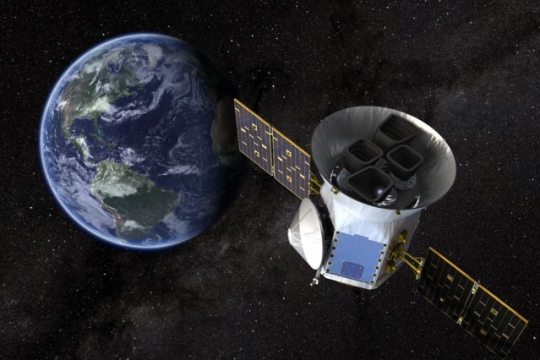
Image: NASA’s Transiting Exoplanet Survey Satellite (TESS), shown here in a conceptual illustration, will identify exoplanets orbiting the brightest stars just outside our Solar System. Credit: NASA’s Goddard Space Flight Center.
Dragomir considers the new planet around HD 21749, some 52 light years from Earth, a milestone in being the mission’s first planet of Earth size, though the expectation is for at least a few dozen more among the nearest and brightest stars as TESS continues sweeping the sky in overlapping sectors. This is a two-year mission that has already discovered 10 planets smaller than Neptune, four of which now have estimated masses. We’re in the early days of this mission, and that’s a good sign. As noted in the paper, “All of these discoveries are based on only the first two sectors of TESS data, suggesting many more are to be found.”
The star is a K-class dwarf in the southern constellation Reticulum that is known to host a second planet, recently confirmed, that is about three times the size of Earth. The paper reports on the discovery and confirmation of HD 21749b and the discovery of HD 21749c, but it is the latter, given its small size, that is receiving the lion’s share of coverage.
The paper notes that spectroscopic and photometric data have made the confirmation of the larger planet possible, while the Earth-sized HD 21749c would be a challenging observation for radial velocity confirmation, if possibly feasible with a dedicated campaign using the combination of the Very Large Telescope (VLT) and the ESPRESSO spectrograph. But density measurements of both planets should be useful. From the paper:
…the density of HD 21749b indicates that it is likely surrounded by a substantial atmosphere. By measuring the density of these two planets (and other similar planets that TESS may find) more precisely, we can begin to observationally constrain the maximum core mass a planet can reach during its formation before accreting a volatile envelope.
The paper is Dragomir et al., “TESS Delivers Its First Earth-sized Planet and a Warm Sub-Neptune,” Astrophysical Journal Letters Vol. 875, No. 2 (15 April 2019. Abstract.

New Planet Detected in Circumbinary System
The transit method has proven invaluable for exoplanet detection, as the runaway success of the Kepler/K2 mission demonstrates. But stars where planets have been detected with this method are still capable of revealing further secrets. Consider Kepler-47. Here we have a circumbinary system some 3340 light years away in the direction of the constellation Cygnus, and as we are now learning about circumbinaries — planets that orbit two stars — the alignment of the orbital plane of the planet is likely to change with time.
Let’s pause for a moment on the value of the detection method. Transits detected in the lightcurve have helped us identify 10 transiting circumbinary planets, with the benefit of allowing astronomers to measure the planets’ radius even as variations in the duration of transits and deviations from the expected timing of the transits establish the circumbinary orbit.
At Kepler-47, we’re looking at the only known multi-planet circumbinary system. Moreover, the orbital period of the binary stars is in the range of 7.5 days, making this the shortest known orbital period for any known circumbinary system. The first two Kepler planets were detected in 2012, but San Diego State University astronomers now find a middle planet between these, Kepler-47d, its strengthening transit signal the result of orbital plane adjustment. In fact, the transit depth for the hitherto undetectable world has become the deepest of the three planets.
Jerome Orosz (SDSU) is the paper’s lead author.
“We saw a hint of a third planet back in 2012, but with only one transit we needed more data to be sure. With an additional transit, the planet’s orbital period could be determined, and we were then able to uncover more transits that were hidden in the noise in the earlier data.”
And according to co-author and SDSU colleague William Welsh, this planet defied expectations by showing up not exterior to the previously known planets but between them. “We certainly didn’t expect it to be the largest planet in the system. This was almost shocking,” said Welsh.
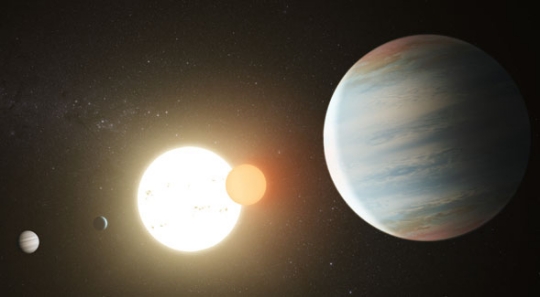
Image: Artist’s impression of the third planet in the Kepler-47 circumbinary system. Credit: NASA/JPL Caltech/T. Pyle.
So what we see at Kepler-47, at least at this juncture, is an inner planet 3.1 times the size of Earth, in an orbit taking 49 days around this G-class star orbiting an M-dwarf. The other planets here are, respectively, 7 times Earth-size on an 187-day orbit (Kepler-47d), and 4.7 Earth-size with a 303 day orbit. Remember that we are talking about planets orbiting two stars, in a system compact enough to fit inside the Earth’s orbit of the Sun.
Kepler-47’s system may be telling us something interesting about planet formation. From the paper:
This is the first detection of a dynamically packed region in a circumbinary system, and it further confirms suspicions that planet formation and subsequent migration can proceed much like that around a single star, at least when far from the binary (Pierens & Nelson 2008, 2013; Kley & Haghighipour 2014, 2015). We also find that, although they are close to having integer commensurate periods, the middle and outer planets are not in a mean-motion resonance-and yet they are gravitationally interacting and exchanging angular momentum, as indicated by their anti-phased oscillations in inclination and eccentricity.
The authors find the planetary configuration dynamically stable for at least 100 million years, adding:
This nearly circular, co-planar, packed configuration is unlikely to have arisen as an outcome of strong gravitational scattering of the planets into their current orbits. Rather, the observations suggest that the planetary configuration is the result of relatively gentle migration in a circumbinary protoplanetary disk.
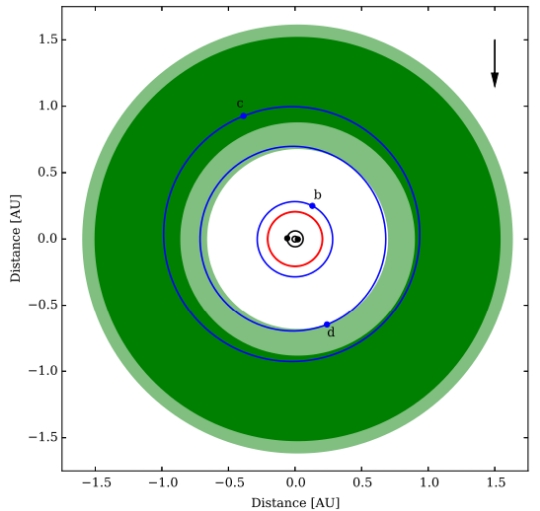
Image: This is Figure 28 from the paper. Caption: The conservative (dark green) and optimistic (light green) habitable zone regions are shown for the Kepler-47 system. The red circle shows the critical stability radius (Holman & Wiegert 1999), interior to which planetary orbits are most likely unstable. Credit: Jerome Orosz/William Welsh et al.
On the matter of habitability, there is little reason to expect life here. These are low density worlds, all three being less dense than Saturn, which implies substantial hydrogen and helium atmospheres. The outer planet receives an average insolation from its two stars that is 86.5 percent of what the Earth receives. But while that puts this world within the boundaries of the circumbinary habitable zone, the density implies a world somewhere in the range between Neptune and Saturn. The newly discovered middle planet skirts the inner edge of the habitable zone, but again its density makes life unlikely.
The paper is Orosz et al., “Discovery of a Third Transiting Planet in the Kepler-47 Circumbinary System,” Astronomical Journal Vol. 157, No. 5 (16 April 2019). Abstract / Preprint.

Huge White Light Flare on a Tiny Star
About 250 light years away there is a faint object that is on the borderline between brown dwarf and star. Only a tenth of the radius of our Sun, ULAS J224940.13-011236.9 was actually too faint for most telescopes to observe until a huge flare lit it up, turning this L dwarf, among the lowest mass objects that can still be considered a star, 10,000 times brighter than it was before. Very cool compared to the average red dwarf, L dwarfs emit radiation primarily in the infrared.
But this story also has to do with visible light, and the question of how such a small object can produce such a powerful explosion. This was a ‘white light’ flare, a type of flare that displays associated brightening in the visible light spectrum. Astronomers believe flares are driven by magnetic energy, the sudden release of which can cause charged particles to heat plasma. In this case the resulting optical, ultraviolet and X-ray radiation was copious.
James Jackman, a PhD student in physics at the University of Warwick (UK) and lead author of the paper on these observations, points to the rare nature of this flare:
“The activity of low mass stars decreases as you go to lower and lower masses and we expect the chromosphere (a region of the star which support flares) to get cooler or weaker. The fact that we’ve observed this incredibly low mass star, where the chromosphere should be almost at its weakest, but we have a white-light flare occurring, shows that strong magnetic activity can still persist down to this level.”

Image: A superflare on an L-dwarf. Credit & Copyright: University of Warwick/Mark Garlick.
And note this from the paper on this work, on the unusual strength of some L dwarf flares:
While seen regularly on GKM stars, observations of white-light flares on L dwarfs remain rare, with only a handful of stars showing them to date (e.g. Paudel et al. 2018). However, those observed have included some of the largest amplitude flares ever recorded, reaching up to V ? ?11 (Schmidt et al. 2016). This shows that white-light flaring activity persists into the L spectral type, despite previous studies of L dwarfs showing their chromospheres and magnetic activity to be diminished compared to those of late M dwarfs.
So a borderline brown dwarf/star is giving us an interesting lesson, perhaps on the difference between the two, because we may be able to determine whether flares like these are limited to actual stars, learning at just what point the activity ceases. Are there other tiny stars, like ULAS J224940.13-011236.9 about the same size as Jupiter, that mark the limits of such flares, below which none occur? Whatever the case, few L dwarfs have produced a flare of this magnitude.
Embedded in future work will surely be the question of how tiny stars like this one store energy in magnetic fields, and their level of chromospheric activity. From the paper:
Ultracool dwarfs are also known to exhibit auroral activity…, which may account for observed H? [hydrogen alpha] emission [when a hydrogen electron falls from its third to second lowest energy level], in these systems. It is expected that the transition from predominantly chromospheric to auroral H? emission occurs during the L spectral type… Many ultracool dwarfs that show activity such as radio emission and flaring also tend to be fast rotators, with rotation periods on the order of hours. However, neither the L1 dwarf SDSSp J005406.55?003101.8 (Gizis et al. 2017a) nor the L0 dwarf J12321827?0951502 (Paudel et al. 2018) showed any sign of rapid rotation when observed by K2, despite showing large amplitude white-light flares. Consequently, we do not attempt to predict whether ULAS J2249?0112 is a fast rotator. Regardless of this, studies of white-light flares such as from ULAS J2249?0112 can aid in understanding exactly how far into the L spectral type chromospheric activity persists.
The J224940.13-011236.9 data come from the Next Generation Transit Survey (NGTS) facility at the European Southern Observatory’s Paranal Observatory, with further data from the Two Micron All Sky Survey (2MASS) and Wide-field Infrared Survey Explorer (WISE), a total observation period of 146 days. The flare occurred on 13 August 2017, with an energy equivalent of 80 billion megatonnes of TNT, surpassing the largest flare (the Carrington event of 1859) ever observed on the Sun.
The paper is Jackman et al., “Detection of a giant white-light flare on an L2.5 dwarf with the Next Generation Transit Survey,” Monthly Notices of the Royal Astronomical Society: Letters Vol. 485, Issue 1 (May 2019), L136-L140 (abstract).


